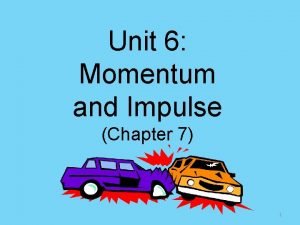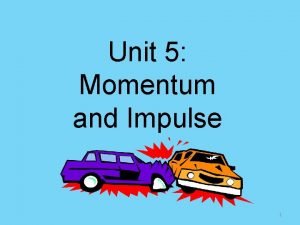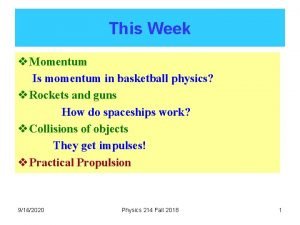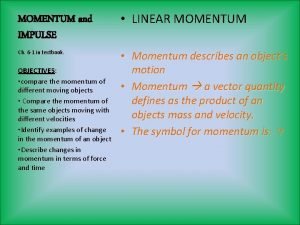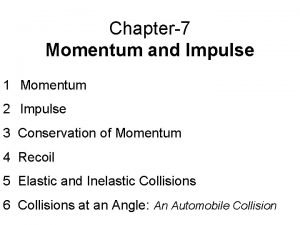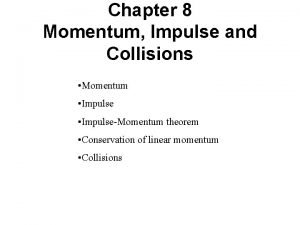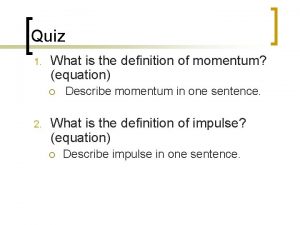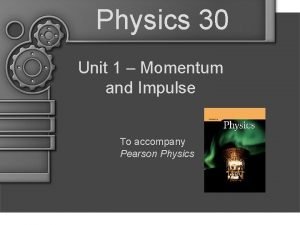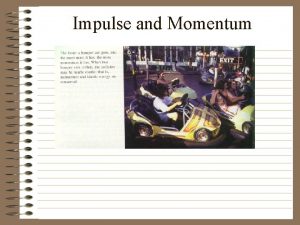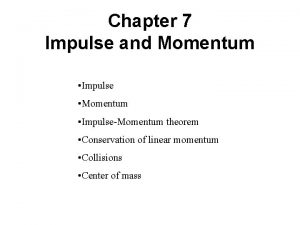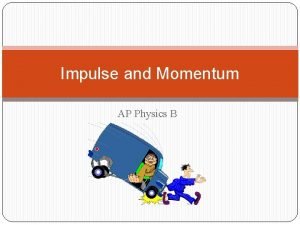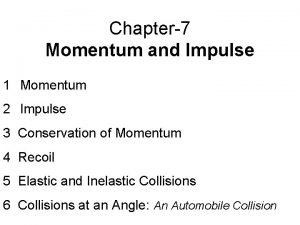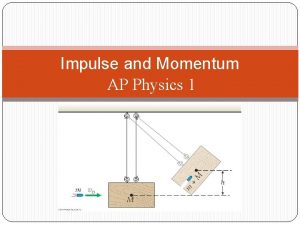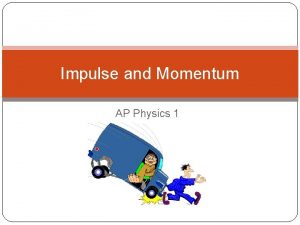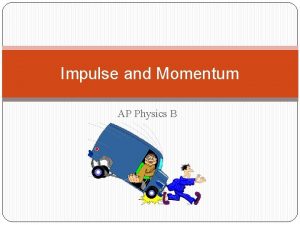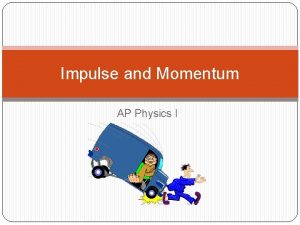Chapter 7 Impulse and Momentum Impulse J The















- Slides: 15

Chapter 7 Impulse and Momentum

Impulse, J The impulse J of a force is the product of the average force and the time interval Dt during which the force acts: Impulse is a vector quantity and has the same direction as the average force. SI Unit of Impulse: newton · second = (N · s) = kg. m/s

Momentum, p The linear momentum p of an object is the product of the object’s mass m and velocity v: Linear momentum is a vector quantity that points in the same direction as the velocity. SI Unit of Linear Momentum: kilogram · meter/second = (kg · m/s) Impulse and momentum, both have the same unit.

IMPULSE–MOMENTUM THEOREM When a net force acts on an object, the impulse of the net force is equal to the change in momentum of the object:

Impulse and Momentum in Sports Impulse and momentum play important roles in sports.

Hitting a baseball Q: How can we determine the impulse? Method-1: Knowing the average force ( ) and contact time (Δt), Impulse = Method-2: Impulse = Area under the Force versus Time graph.

Hailstones Versus Raindrops Unlike rain, hail usually does not come to rest after striking a surface. Instead, the hailstones bounce off the roof of the car. If hail fell instead of rain, would the force on the roof be smaller than, equal to, or greater? Answer: Greater

Example A baseball (m = 0. 14 kg) has an initial velocity of v 0 = – 38 m/s as it approaches a bat. We have chosen the direction of approach as the negative direction. The bat applies an average force that is much larger than the weight of the ball, and the ball departs from the bat with a final velocity of vf = +38 m/s. Determine the impulse applied to the ball by the bat.

Definitions of Terms Internal forces Forces that the objects within the system exert on each other. External forces Forces exerted on the objects by agents that are external to the system. An isolated system is one for which the vector sum of the external forces acting on the system is zero.

7. 2 The Principle of Conservation of Linear Momentum The total linear momentum of an isolated system remains constant (is conserved).

EXAMPLE 5 Assembling a Freight Train A freight train is being assembled in a switching yard, and Figure 7. 10 shows two boxcars. Car 1 has a mass of m 1 = 65× 103 kg and moves at a velocity of v 01 = +0. 80 m/s. Car 2, with a mass of m 2 = 92× 103 kg and a velocity of v 02 = +1. 3 m/s, overtakes car 1 and couples to it. Neglecting friction, find the common velocity vf of the cars after they become coupled.

EXAMPLE 6 Ice Skaters Starting from rest, two skaters “push off” against each other on smooth level ice, where friction is negligible. As Figure 7. 11 a shows, one is a woman (m 1 = 54 kg), and one is a man (m 2 = 88 kg). Part b of the drawing shows that the woman moves away with a velocity of vf 1 = +2. 5 m/s. Find the “recoil” velocity vf 2 of the man.

Collisions are often classified according to whether the total kinetic energy changes during the collision: 1. Elastic collision—One in which the total kinetic energy of the system after the collision is equal to the total kinetic energy before the collision. 2. Inelastic collision—One in which the total kinetic energy of the system is not the same before and after the collision; if the objects stick together after colliding, the collision is said to be completely inelastic.


Collisions in One Dimension 1. Apply the conservation of momentum. 2. If the collision is elastic, apply the conservation of energy.
 Conceptual physics chapter 6 momentum
Conceptual physics chapter 6 momentum Work energy theorem
Work energy theorem Unit 6 momentum and impulse
Unit 6 momentum and impulse Units of momentum
Units of momentum Momentum in basketball physics
Momentum in basketball physics Principle of linear impulse and momentum
Principle of linear impulse and momentum Linear momentum and linear impulse
Linear momentum and linear impulse Importance of momentum
Importance of momentum Poem about impulse and momentum
Poem about impulse and momentum A 2250 kg car traveling to the west slows down
A 2250 kg car traveling to the west slows down Importance of momentum and impulse
Importance of momentum and impulse Momentum and impulse formula sheet
Momentum and impulse formula sheet Conservation of momentum in sports
Conservation of momentum in sports The momentum principle
The momentum principle Definition of momentum
Definition of momentum Physics 30 momentum and impulse
Physics 30 momentum and impulse


